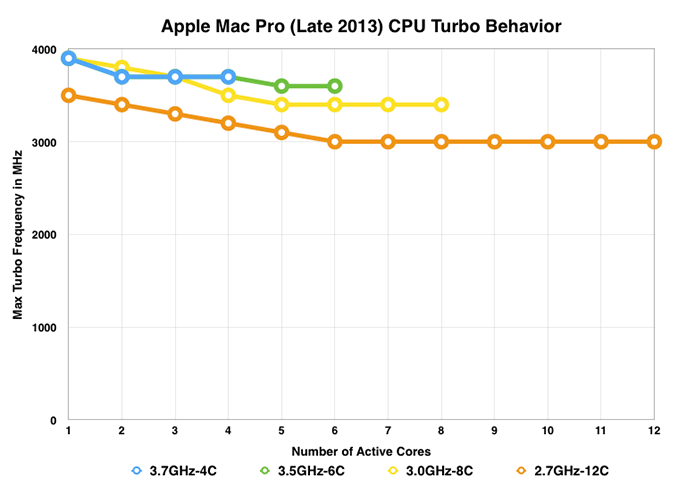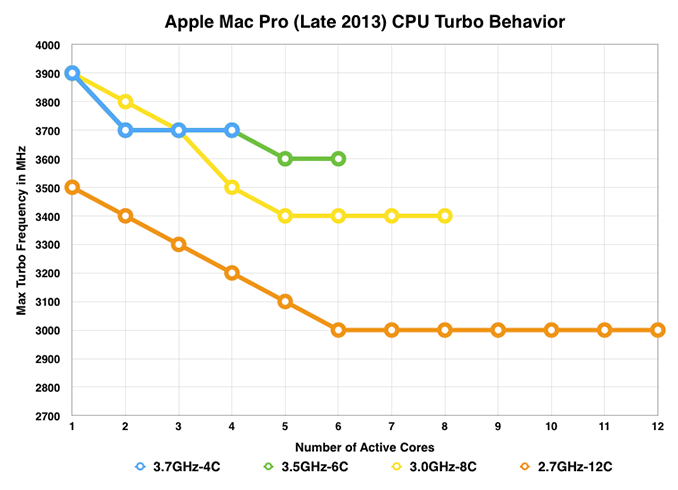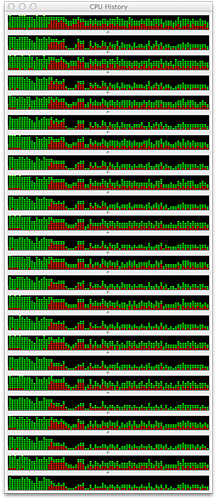The Mac Pro Review (Late 2013)
by Anand Lal Shimpi on December 31, 2013 3:18 PM ESTCPU Choices
Had I gotten around to publishing my rMBP review prior to this one you would’ve seen my praise Apple’s CPU selection abilities as of late. Outfitting all 15-inch rMBPs with Crystalwell was a very wise move on Apple’s part. With the Mac Pro the CPU selection is good, but the decision of what to buy is far more complex than in any other product line.
The Mac Pro not only serves as Apple’s ultra high end Mac, but it’s the only option if your needs exceed that of an iMac or 15-inch MacBook Pro. Literally anyone who needs more performance than Apple offers in an all-in-one or a notebook inevitably is pushed to consider the Mac Pro. With a relatively broad professional audience in mind, Apple offers more CPU options for the Mac Pro than on any other shipping Mac:
| Mac Pro (Late 2013) CPU Options | ||||||
| Intel CPU | Xeon E5-1620 v2 | Xeon E5-1650 v2 | Xeon E5-1680 v2 | Xeon E5-2697 v2 | ||
| Cores / Threads | 4 / 8 | 6 / 12 | 8 / 16 | 12 / 24 | ||
| CPU Base Clock | 3.7GHz | 3.5GHz | 3.0GHz | 2.7GHz | ||
| Max Turbo (1C) | 3.9GHz | 3.9GHz | 3.9GHz | 3.5GHz | ||
| L3 Cache | 10MB | 12MB | 25MB | 30MB | ||
| TDP | 130W | 130W | 130W | 130W | ||
| Intel SRP | $294 | $583 | ? | $2614 | ||
| Apple Upgrade Cost (Base Config) | - | +$500 | +$2000 | +3500 | ||
| Apple Upgrade Cost (High End Config) | - | - | +$1500 | +3000 | ||
There are four CPU options, each with varying core counts. The more cores you get, the lower your base CPU frequency is. In the old days, that would be the end of the discussion - you either choose more cores or more frequency, a tradeoff that is ultimately determined by your workload. Starting with its Nehalem architecture back in 2008, Intel introduced two key technologies that changed the face of multicore on the desktop: power gating and turbo boost. The former is a technology that can almost entirely remove power to a core (both active and leakage) when idle, while the second takes advantage of that freed up thermal budget to drive any active core(s) at higher frequencies. Subsequent implementations of Intel’s Turbo Boost technology have scaled the aggressiveness of this opportunistic frequency scaling, but the basic principle remains the same.
Apple advertises core count and base frequency for all of the Mac Pro CPU options, but to really understand what you’re getting yourself into you need to look at each CPU’s max turbo states vs. number of active cores. Neither Apple nor Intel do a great job of publicly exposing this information, Apple avoids doing so in order to keep things clean/simple, and Intel avoids doing so because perhaps it’s fun? Either way I’ve compiled the data on the four CPU options into the charts below.
I've left base clocks out of the graphs although you can see them noted in the legend at the bottom of each chart.
This first chart has the y-axis starting at 0MHz, but the next one is the more interesting as it starts at 2.7GHz and better illustrates/exaggerates the sort of frequency tradeoff you can expect vs. core count:
The 4, 6 and 8 core CPU options all offer the same peak single core frequency (3.9GHz). This is very important as single threaded performance remains the gate for system responsiveness outside of thread heavy applications. The 12-core CPU sacrifices around 10% of this peak single core performance.
Early on the 8-core CPU holds the advantage over the rest, being able to hit a higher 2-core max turbo. The octa-core’s crossover point happens at 3 active cores, beyond this point the quad and six core CPUs maintain a slight max turbo advantage.
The key takeaway here is that more cores isn’t necessarily better. You need to weigh the needs of your applications against the number of cores in your system. There is no one-size-fits-all answer here. For kicks I looked at the CPU load for a handful of my benchmarks:
![]()
![]()
![]()
Application version seems to have a huge impact on threading. Running our Photoshop benchmark on CS5 vs. CS6 is the difference between loading 2 - 8 cores vs. 3 - 10. The same is true if I compare Final Cut Pro 10.0 vs. 10.1; the latest version from Apple (optimized for the new Mac Pro), makes great use of all 12 cores/24 threads. Workload also has an impact. I took our old Final Cut Pro 10.0 benchmark (1080p) and ran it on 10.1, saw a maximum of 1217% CPU usage. I ran our new 4K benchmark on 10.1 and saw nearly full virtual core utilization (2114% CPU usage).
![]()
Final Cut Pro 10.0 - 1080p Benchmark
![]()
Final Cut Pro 10.1 - 1080p Benchmark
![]()
Final Cut Pro 10.1 - 4K Benchmark
Offline 3D rendering applications typically have the easiest time of chewing up tons of cores, while many others are likely better suited by having fewer cores running at a higher frequency. There's also a serious multitasking benefit if you're the type of person that runs multiple thread heavy workloads in parallel. It's pretty nice having a fairly responsive system while rendering a beefy 4K project in Final Cut Pro. The responsiveness comes courtesy of having a ton of cores in addition to extremely fast IO. That PCIe SSD definitely comes in handy.
If you want the best balance of heavily threaded performance without sacrificing performance in lighter workloads, the 8-core configuration seems to be the best bet. There are definitely bragging rights associated with the 12-core system, but unless you absolutely need a ton of cores you’re likely better suited by the 8-core configuration.













267 Comments
View All Comments
stevesup - Wednesday, January 1, 2014 - link
Great review, per usual. Even Leo Laporte couldn't dig out a negative nugget to bash Apple with.milkod2001 - Wednesday, January 1, 2014 - link
In a few months a market will probably be flooded with similar cases. Something like semitransparent case in this shape with decent led lighting could actually look quite nice.Back in Windows Vista times I was working with Mac Pro and iMac as graphic designer. It was a pleasure to work with compared to crappy, slow Vista based Pc.
Now with w7 I can't think about single reason I'd want to spend almost twice for Mac Pro compared to W7 Pc(obviously nobody is forcing me to).
Good job with review Anald.
milkod2001 - Wednesday, January 1, 2014 - link
sorry about misspelled name, can't find edit option for postMat9912 - Wednesday, January 1, 2014 - link
Can someone comment on the power consumption of the new Mac Pro when in standby/sleep mode?knweiss - Thursday, January 2, 2014 - link
You'll find the info in the Mac Pro Environmental Report:http://images.apple.com/environment/reports/docs/M...
nomorespam - Wednesday, January 1, 2014 - link
Any idea why the three networking ports couldn't have been combined into a single PCIe 2.0 lane with a switch/bridge?By my math this comes to at most 3.3Gbps (412MB/s) unidirectional with all three ports saturated.
Is this not a possibility or are there other considerations that make this impractical or undesirable?
I'm thinking it would be really nice to get another 2 (ideally 3 for no bottleneck) of the PCIe 2.0 lanes to the USB 3.0 ports and this seems like a valid way to triple available USB 3.0 bandwidth.
The only other place I can see to steal an additional PCIe 2.0 lane back to get to 4 port bottleneck free USB 3.0 I/O is to take one lane away from the SSD controller?
Surely doing so reduces the bus width and resulting net performance even though the theoretical 1.5GB/s that three PCIe 2.0 lanes provide is still faster than the Mac Pro's shipping SSD's?
Like Neil above, I would also like to know more about IP over thunderbolt 1 and 2 and how it works in the real world today - I would suspect the network stack is not in any way optimized for it at this point.
OreoCookie - Wednesday, January 1, 2014 - link
@AnandAny reason why you haven't posted results on your SSD consistency tests for the Mac Pro?
wozwoz - Wednesday, January 1, 2014 - link
Nice review - though rather too long. Sometimes, less is more :)Unfortunately, what is not answered, and remains 'unknown' is:
* Is a D500 graphics card actually any faster than a D300 in real-world tests? [Note that the D500 has a lower clock speed]
* Since the D700 apparently consumes vastly more power than the D300, how does the graphics card effect noise levels and thermal performance of the entire machine?
I liked your chart of CPU turbo boost, as the number of cores in play changes ... first decent explanation of that issue.
bizarrefish - Wednesday, January 1, 2014 - link
Excellent review Anand, very comprehensive and just what I needed to help seal the decision to buy. I believe some of your benchmarks and stress testing was under Boot Camp Windows correct? I too want to use the system as my main Workstation/PC at home but for occasional gaming also. The system will spend most of its time in OSX but Is the driver support good enough to perform well in Boot Camp for modern gaming needs? Thanks.jackbobevolved - Saturday, April 19, 2014 - link
I got the 12 core D700 model and it works great for gaming. The latest Catalyst drivers installed without issue and performance has been amazing. What really blew me away though was comparing the render and export speed on this machine against my old 3,1 8 core with a Radeon 5870. Several hour exports from FCPX were cut to just minutes.